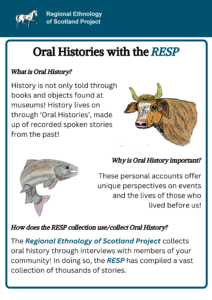Written by: James Rice, RESP Outreach Intern
With my pitch given and what I hoped to achieve with my internship outlined, I could begin planning how to carry out my responsibilities.
In the first week of February, I dedicated a lot of my time to exploring our online archive for a few reasons. First and foremost, having decided to produce a number of activity sheets, I wanted to determine what themes I would focus upon, as well as what entries I could potentially use for their recordings. Eventually, after meeting with the team, we decided that themes relating to ‘Sport and Games’, toys, transport, the changing environment, and food to name a few, were ideal for worksheets aimed at kids. We also thought that an Oral History worksheet that described the significance of oral histories and the ability to record spoken stories was perfect here, as it would bring more attention to the reason why the RESP archive is so special. By the end of the month, I had begun to draft some of these sheets for this purpose.

‘Oral Histories with the RESP’ worksheet, page 1, created by James Rice
Second to this, in regard to producing promotional materials such as postcards, having a variety of images from the entries within the project itself on-hand was important. While we did consider using images from Scottish archives with permission for some of our postcards, we concluded that it would be more appropriate to use our own images to invite the public to see what our archive could offer them. In this light, I decided with my colleague, Rebekah, that I would use ‘Canva’ as a free editing software to produce these materials.
Third and finally, having also decided to eventually produce a video tutorial for the website, being hands on with the archive was the best way to familiarise myself in preparation for the video itself. Fortunately, the process of editing and finalising this video wasn’t too much of a challenge, as I already had some experience with recording software and using ‘Adobe Premiere Pro’ for short videos I made with friends. Yet, as we hoped that this video would be relatively short, I admittedly struggled to be as informative as possible while keeping this limited. Nevertheless, I was prepared to start recording raw footage and audio for several drafts to be discussed with the team.
Alongside these responsibilities, I had also begun planning the launch event on the 1st of May for our online exhibition led by curator Rebekah Day. This involved organising and booking the physical space for the event in the CRC, as well as liaising with Daryl Green, Head of Heritage Collections at the University, to organise an opening speech on the day. I also started putting together an ‘Eventbrite’ page for the launch itself, giving guests a platform to accept their invites and a relatively easy way for myself to keep track of those attending.
While this period involved a lot of planning ahead for my role, there was still a lot for me to do over the next coming months ahead of the launch. Nevertheless, I was particularly proud of what I had been able to accomplish thus far, and felt far more confident in my role in light of the previous month, when I was still finding my footing for what I wanted to achieve.
